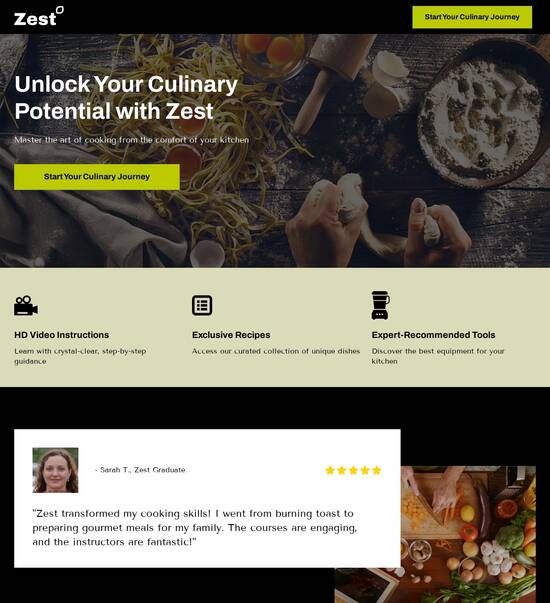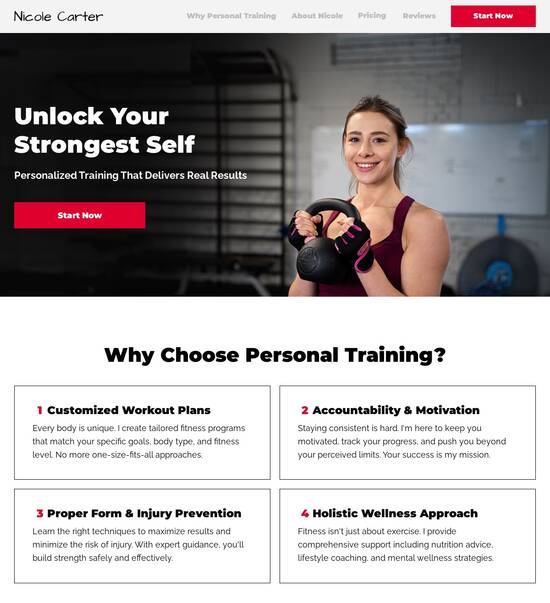
HTML5 optimized collaborative website template
Explore Similar TemplatesAbout template
Leverage our intuitive page builder and high-converting HTML5 optimized collaborative website template.
Recommended templates

Easy to build without coding
With the intuitive drag-and-drop builder, anyone on your team can create high-converting pages without any knowledge of code or design. Make enhancements to your landing page with custom widgets using Javascript, HTML/CSS, or third-party scripts.

Multiple layouts for any industry and goal
Select from 500+ landing page layouts built to boost conversions across industry-specific scenarios. Customize them by adjusting fonts, adding images, and generating on-brand content with the AI assistant. Quickly scale with Instablocks® and Global Blocks that you can save, reuse, and update globally.

Loads fast and looks polished on any device
Every template is responsive, which means they present professionally on any device and load blazingly fast with our Thor Render Engine. You can also power them up with Google AMP technology to deliver an unparalleled mobile experience and drive higher conversions.

Robust analytics & experimentation
Get real-time updates and reporting across all your devices, showing the number of visitors, conversions, cost-per-visitor, and cost-per-lead. Launch AI-powered experiments, run A/B tests, and use heatmaps to analyze user behavior, then optimize your landing page to maximize conversions.







Easy to build without coding
With the intuitive drag-and-drop builder, anyone on your team can create high-converting pages without any knowledge of code or design. Make enhancements to your landing page with custom widgets using Javascript, HTML/CSS, or third-party scripts.
Multiple layouts for any industry and goal
Select from 500+ landing page layouts built to boost conversions across industry-specific scenarios. Customize them by adjusting fonts, adding images, and generating on-brand content with the AI assistant. Quickly scale with Instablocks® and Global Blocks that you can save, reuse, and update globally.
Loads fast and looks polished on any device
Every template is responsive, which means they present professionally on any device and load blazingly fast with our Thor Render Engine.
Robust analytics & experimentation
Get real-time updates and reporting across all your devices, showing the number of visitors, conversions, cost-per-visitor, and cost-per-lead. Launch AI-powered experiments, run A/B tests, and use heatmaps to analyze user behavior, then optimize your landing page to maximize conversions.
All the features you need to build lead-generating landing pages
Explore more featuresLearn how to build top-performing landing pages for any goal
FAQs
Leading the way in building high-performing landing pages





A step-by-step guide to creating powerful landing pages with Instapage
Creating effective landing pages is crucial for maximizing your marketing ROI, especially in today’s competitive landscape. Instapage provides an exceptional platform that empowers marketers to accelerate their campaigns through optimized landing pages and conversion rate optimization (CRO) strategies. This guide will walk you through the essential steps to leverage Instapage’s features for effective digital marketing.
Understanding the benefits of using Instapage
Before diving into the steps of creating a landing page, it’s vital to understand the unique benefits Instapage offers. The platform delivers an all-in-one solution for marketers, combining user-friendly design tools with powerful optimization features to enhance conversion rates. With over 100 high-converting templates and lead generation elements available, you can create compelling landing pages without needing coding skills.
- Access to 100+ ready-to-use templates: These templates are designed for high conversion rates, saving you time while capturing leads effectively.
- Built-in experimentation tools: Experiment with A/B testing and heatmaps to refine your landing pages and understand visitor behavior.
- Personalization capabilities: Leverage dynamic text replacement and audience targeting features to create tailored experiences for different demographics.
Step 1: Initiating your campaign with a solid landing page strategy
The first step involves defining your campaign goals and target audience. Knowing your audience will allow you to tailor your messaging and design effectively.
- Identify your target audience: Choose segments from the verticals of business services, education, or tech/SaaS.
- Set specific goals: Are you aiming for lead generation, sales conversion, or awareness? Your goals will dictate the design and content of your landing page.
- Research competitor strategies: Understanding what works for your competitors can provide insights into effective design and messaging.
Step 2: Designing your landing page for optimal performance
Creating the landing page itself comes next. Instapage's drag-and-drop interface makes it simple to design pages that are not only visually appealing but also conversion focused.
- Utilize Instablocks: These pre-designed sections can be combined to create tailored layouts that enhance user experience.
- Incorporate lead generation forms: Make it easy for visitors to convert by strategically placing forms that collect lead info.
- Implement strong calls-to-action (CTAs): Ensure that CTAs stand out and compel users to take the desired action.
Step 3: Optimizing and launching your landing page
Once your landing page is designed, it’s crucial to optimize it for performance before launching. Use the built-in analytics tools to monitor user engagement and refine your strategy as necessary.
Regularly reviewing performance metrics will allow you to make informed adjustments that drive better results over time. Focus on points of engagement and conversions to gauge the success of your landing page.
By following these steps with Instapage, you can create high-converting landing pages that drive significant results for your marketing campaigns. Ready to get started? Sign up today and transform your marketing approach!
HTML5 Optimized Collaborative Website Template
Understanding HTML5 optimized collaborative website templates
Collaborative website templates have revolutionized the way teams work online. These templates serve as a foundation for building websites that facilitate teamwork and shared projects, enabling multiple users to collaborate in real-time. The significance of collaboration in web development cannot be overstated, as it allows teams to leverage diverse skill sets, streamline project timelines, and improve overall efficiency. HTML5 plays a crucial role in this context, offering robust features that enhance the functionality of collaborative templates, making them more interactive and user-friendly.
Definition of collaborative website templates
Importance of collaboration in web development
Overview of HTML5 as a foundational technology
HTML5 stands out as a pivotal development in web technologies, supporting multimedia elements and API integrations that enrich user experience. The synergy of collaboration and HTML5 equips teams with the tools to create responsive and interactive websites that can adapt to various user needs and devices.
Key features of HTML5 optimized templates
One of the cornerstone advantages of HTML5 optimized collaborative website templates is their focus on responsive design. Templates that adhere to responsive design principles ensure that web pages render well across a variety of devices, from desktops to smartphones. This utilizes fluid grids and layouts to adjust the content dynamically based on the screen size, enhancing usability without compromising aesthetics.
Fluid grids and layouts
Media queries for various devices
Moreover, HTML5 offers enhanced audio and video support through native multimedia elements, eliminating the need for cumbersome plugins and ensuring seamless playback across different browsers. This cross-browser compatibility enhances the user experience, making collaborative interaction more engaging and effective.
Core functionalities of HTML5 in collaborative templates
HTML5 brings several functionalities that optimize collaborative website templates. One of them is the implementation of 'iolazy', a lazy-loading approach that boosts website performance by loading images and other resources only when they become visible within the viewport. This reduces the initial load time significantly, ultimately delivering a smoother user experience.
Definition and role of iolazy
Benefits of lazy loading images and content
Implementation tips for seamless integration
Additionally, understanding event handling using document.addEventListener is essential for managing user interactions effectively. Capturing various user events such as clicks and form submissions allows collaborative features to instantly reflect changes, maintain seamless synchronizations, and ensure every participant is up-to-date, enhancing the overall experience.
Collaboration features enhancing user experience
Real-time editing and synchronization are fundamental components of collaborative website templates. This feature enables multiple users to edit documents simultaneously without conflicts. By employing web sockets instead of traditional HTTP requests, templates can ensure instantaneous data transmission, creating a dynamic working environment. This significantly enhances user engagement through feedback loops, allowing team members to see changes made by others in real time.
How collaborative editing works
Role of web sockets vs. traditional HTTP requests
User engagement and feedback loops
To augment collaboration, version control and change tracking play vital roles. Maintaining version histories allows users to revert changes or view past iterations, ensuring that no significant amendments are lost. This also aids in providing notifications regarding updates, which is essential for keeping all participants informed.
Integration of APIs and third-party tools
The integration of various APIs enhances the functionality of collaborative website templates significantly. Popular collaboration APIs such as Google Docs and Slack offer tools that streamline communication and document sharing, fostering an efficient workflow. By employing seamless integration strategies, teams can access these tools directly within their templates, ensuring a fluid user experience.
Popular APIs for online collaboration
Seamless integration strategies
Enhancements provided by third-party plugins
Furthermore, the incorporation of project management capabilities into these templates helps teams maintain alignment on tasks and deadlines. Features that facilitate real-time communication ensure that all team members are aware of project developments, thereby promoting accountability.
Customization and flexibility in design
Customization plays a crucial role in the effectiveness of HTML5 optimized collaborative website templates. With the ability to utilize custom CSS and JavaScript, teams can personalize templates for unique branding experiences. This flexibility allows users to infuse their individual styles while also adding functionalities tailored to their specific needs.
Personalizing templates for unique branding
Adding custom functionalities with JavaScript
Strategies for utilizing CSS pre-processors
Another aspect of design that significantly enhances user experience is a user-friendly interface. This involves well-structured navigation menus, buttons, and forms that simplify interactions. Adhering to accessibility standards ensures that the templates cater to a wider audience, which is key in collaborative environments.
Performance and SEO optimization techniques
To ensure a smooth experience, enhancing load times and overall responsiveness is essential. HTML5 features can be leveraged to minimize render-blocking resources, such as using the 'async' and 'defer' attributes for scripts to ensure that loading sequences do not hinder user interaction. This leads to websites that feel immediate and responsive, a critical aspect of keeping users engaged in collaborative tasks.
Leveraging HTML5 features for optimal performance
Minimizing render-blocking resources
Additionally, SEO practices tailored for HTML5 collaborative templates can enhance search visibility. Structuring HTML with effective use of headings, alt text, and meta tags is pivotal in gaining better rankings in search results. Implementing schema markup adds another layer of optimization, ensuring that content is well-understood by search engines.
The future of collaborative web development through HTML5
Looking ahead, trends in collaborative design tools are emerging, particularly with the rise of AI and automation. As these technologies develop, they promise to further refine collaborative workflows and enhance user experiences. Anticipated advancements in web standards and frameworks will likely influence how collaborative websites are built and function, making it crucial for developers to stay abreast of these changes.
The rise of AI and automation in collaboration
Anticipated developments in web standards and frameworks
Future implications for collaborative workflows
Preparing for the next generation of web collaboration necessitates a continuous learning mindset among developers. As the landscape evolves, understanding new tools and methodologies will be critical in maintaining effective collaborative development practices.
Ready to skyrocket conversions?
Supercharge your ad campaigns with high-performing landing pages
Get started














